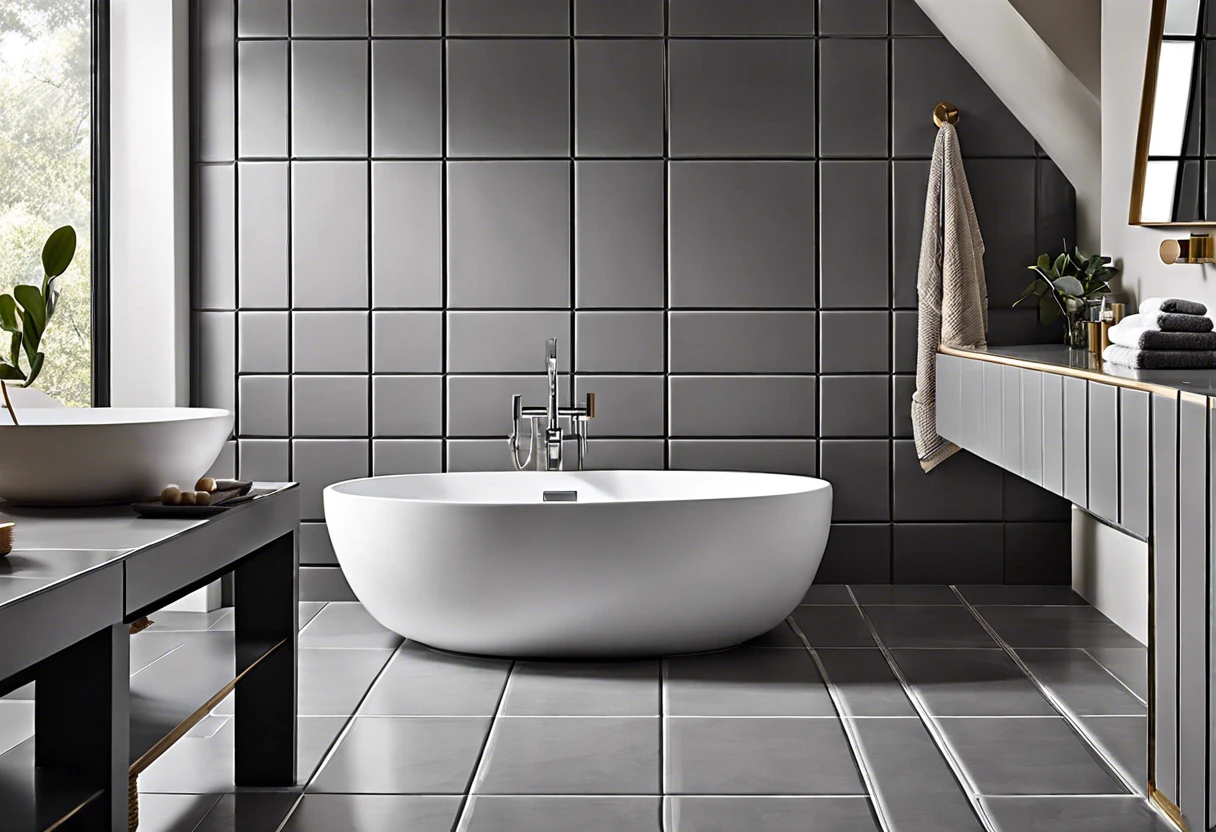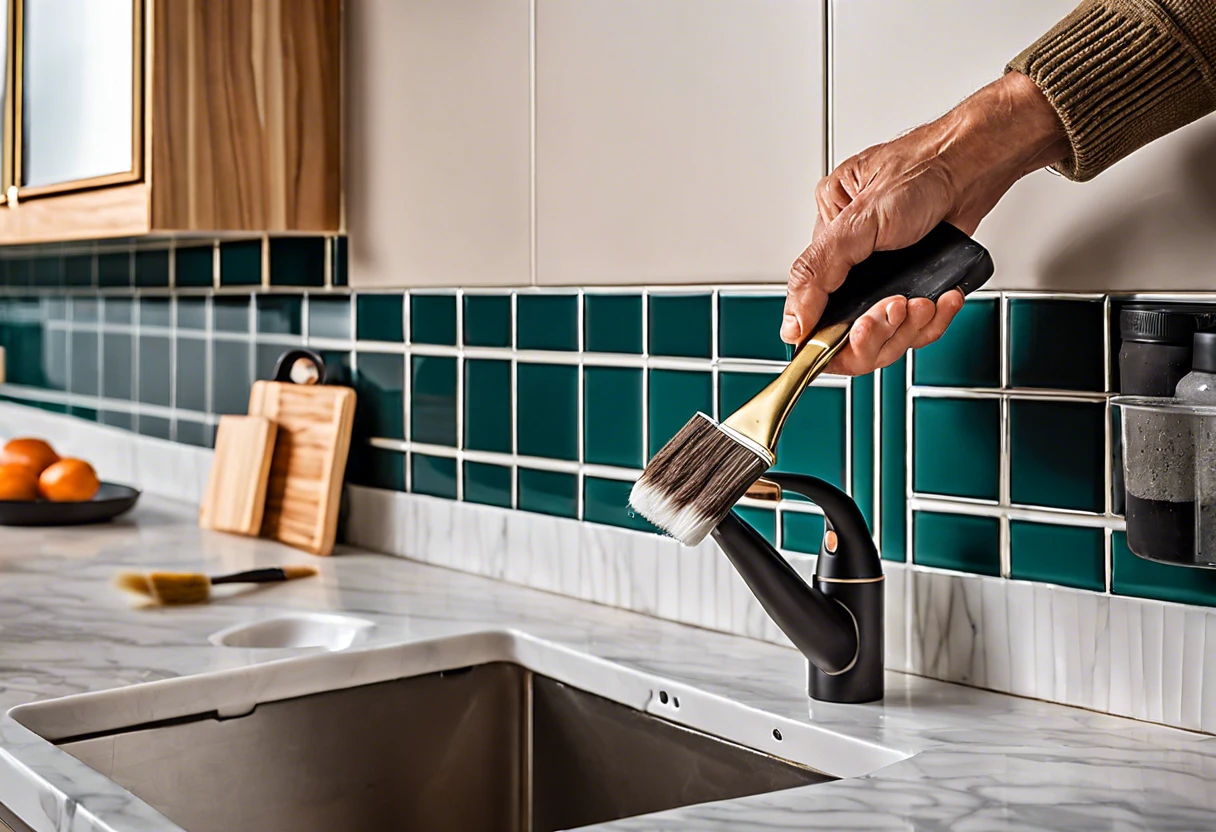Can You Paint Grout Lines?
Published on: May 1, 2025 | Last Updated: January 7, 2025
Written By: Alisha Winters
Grout lines are the tiny spaces between tiles that help hold them together. Think of them as the glue that keeps your colorful tile artwork looking neat!
You might be wondering, can you paint grout lines? It’s important to know because, after years of use, they can look dull or dirty. I’ve tried painting grout in my own home, and trust me, it can totally transform a space.
In this article, we’ll dive into what grout lines are, the must-know tips before painting them, a step-by-step painting guide, suitable paint types, color palettes, and factors that affect how long your paint will last. Plus, we’ll discuss common issues, finishing touches, and fun DIY ideas related to painting grout lines.
Contents
- 1 Can You Paint Grout Lines?
- 2 What Are Grout Lines?
- 3 Essential Considerations Before You Start Painting Your Grout Lines
- 4 Step-by-step Guide to Painting Grout Lines
- 5 Recommended Color Palette for Painted Grout Lines
- 6 Types Of Paint Suitable for Grout Lines
- 7 Factors Affecting the Longevity Of Painted Grout Lines
- 8 Finishing Touches: Making Your Grout Lines Pop
- 9 Creative DIY Project Ideas Using Painted Grout Lines
- 10 Maintenance Tips for Painted Grout Lines
- 11 Frequently Asked Questions About Painting Grout Lines
- 12 Conclusion: Achieving Beautifully Painted Grout Lines
- 13 Useful Resources
Can You Paint Grout Lines?
Yes, you can paint grout lines! Use a specialty grout paint or a marker designed for this purpose. Proper cleaning and sealing beforehand help ensure better results. Keep in mind, it might need redoing every few years. If you’re looking to refresh your bathroom’s appearance, bathroom tile painting techniques can transform your space with minimal effort.
The Finishing Touch
A freshly painted wall is a blank canvas. The best way to bring your room to life is with a single piece of statement art that ties everything together.
Browse Wall Art at Big Wall DecorWhat Are Grout Lines?
Grout lines are the thin seams between tiles, filled with a cement-like substance called grout. They typically measure 1/16 inch (1.58 Mm) to 1/8 inch (3.18 Mm) wide, helping to stabilize tiles and prevent moisture from seeping beneath them.
As for painting grout lines, that’s a different story! I’ve tried painting grout in my home to see if it would improve the look; I learned some do’s and don’ts during the process.
In my experience, I used it for a job to create a stunning tile mural, which really changed the room’s vibe. It taught me a valuable lesson about painting grout lines—the quality of grout matters significantly, and it can make or break the aesthetic you’re aiming for.
Essential Considerations Before You Start Painting Your Grout Lines
What do you need to prepare for?
- Grout Paint: You’ll need a grout paint like Fusion Pro or Miracle Sealants 511. This paint bonds well, ensuring durability on your grout lines.
- Grout Brush: A good grout brush, such as the MOSO GRP-PG01, is essential. It scrubs the grout effectively, allowing the paint to adhere properly.
- Sealer: Use a quality sealer like Aqua Mix Grout Sealer after painting. It protects against stains and moisture, extending the life of your work.
- Masking Tape: Apply painter’s tape, like FrogTape, to surrounding surfaces. It ensures clean edges and keeps paint off unwanted areas.
We covered important factors to consider before painting grout lines. We will now cover a step-by-step guide for the process.
Also See: Can You Paint Bathroom Tiles? Yes, and Here’s How!

Step-by-step Guide to Painting Grout Lines
Here are the steps to paint your grout lines for a fresh look.
-
Clean the Grout Thoroughly
Start by scrubbing your grout lines. Use a mix of warm water and vinegar in a 1:1 ratio to break down dirt and grime.
This process may take about 30 minutes, depending on the area size. A toothbrush works wonders!
-
Select the Right Paint for Grout
Choose high-quality grout paint designed for the task; look for epoxy-based paints for durability. Products often recommend coverage of about 100 sq. ft. (9.29 Square Meters) per quart (0.946 Liters). Professional painters know that understanding the interior painting techniques can enhance overall painting techniques.
Avoid regular wall paint, as it won’t adhere well over time. I learned that the hard way and had to repaint after a few months!
-
Prepare the Area
Tape off the edges around the grout lines using painter’s tape. This ensures a clean edge and prevents spills.
This step is simple, but attention to detail keeps the job neat and professional-looking. You’ll thank yourself later!
-
Apply the Paint
Use a small brush or pen applicator for precision when painting the grout. Apply a thin coat first, allowing it to dry for about 24 hours before deciding if a second coat is needed.
I suggest testing the paint in an inconspicuous spot. That small test can save you from future regret!
-
Seal the Grout Lines (Optional)
If you want extra durability, consider sealing the grout with a clear sealant once the paint is fully dry. It adds a protective layer that can last up to five years.
However, it’s not mandatory; some prefer a less glossy look! It’s all about what works best for your style.
We covered the process of painting grout lines step-by-step. We will now discuss the suggested color palette for painted grout lines.
The Finishing Touch
A freshly painted wall is a blank canvas. The best way to bring your room to life is with a single piece of statement art that ties everything together.
Browse Wall Art at Big Wall DecorRecommended Color Palette for Painted Grout Lines
I recommend a calming Ocean Breeze palette to create a serene environment, using soft blues and earthy neutrals that blend well together.
| Color Box | Hex Code | Color Name |
|---|---|---|
| #A0D1E6 | Light Sky Blue | |
| #007B8C | Teal | |
| #D9D688 | Soft Sand | |
| #FFF8E7 | Pale Peach |
That covers suggested color schemes for grout lines. Let’s now take a look at suitable paint types for grout lines.
Types Of Paint Suitable for Grout Lines
Let’s explore the types of paint you can use for grout lines: epoxy, latex, special grout paint, and penetrating sealers.
-
Epoxy Paint
Epoxy paint offers unmatched durability. It resists water and mildew, making it ideal for kitchens and bathrooms where grout lines often get wet.
-
Latex Paint
Latex paint is versatile and adheres well to grout. It’s easy to clean up—great for DIY projects—but might not hold up in high-moisture areas.
-
Special Grout Paint
Special grout paint is designed specifically for this task. It penetrates and seals, providing excellent adhesion to the grooved surface without flaking off.
-
Pens or Markers
Pens or markers designed for grout have precision tips, allowing you to touch up your grout without the mess of full paint application—perfect for quick fixes.
Having faced similar situations, I always choose epoxy paint for my grout. It delivers the best results in longevity and waterproofing.
You should now have a good understanding of suitable paint types for grout lines. In the next part, we’ll discuss longevity factors of painted grout.

Factors Affecting the Longevity Of Painted Grout Lines
So, what factors affect the decision to paint grout?
-
Type of Grout: Different grouts absorb paint differently; epoxies are challenging.
-
Quality of Paint: High-quality paint lasts longer and resists chipping better.
-
Surface Preparation: Proper cleaning and priming improve paint adhesion.
-
Environmental Conditions: Temperature and humidity during painting affect drying and durability.
Finishing Touches: Making Your Grout Lines Pop
After your paint has fully dried—about 24 hours at room temperature (20°C / 68°F)—gently remove any dust with a soft, damp sponge. Reapply a sealer every 6–12 months to maintain shine.
Inspect grout lines for cracks or faded paint every six months using a 10x magnifying glass. Check for chips or wear, and use products like Acid-Free Grout Cleaner as needed.
From one expert to another, always sand the grout lines with 120-grit sandpaper before repainting for better adhesion. This preparation ensures longevity!
Creative DIY Project Ideas Using Painted Grout Lines
Ready to transform your space? How about creating stunning art tiles by painting grout lines between colorful tiles? You can also create a fun outdoor mural on a concrete patio with bold designs framed by fresh, painted grout lines. If you’re curious about expanding your painting techniques, painting fabric and other surfaces offers exciting creative possibilities.
For these projects, you’ll need tile paint, a brush, and sealer. They’ll run you about $30-$50 and take a weekend to complete—totally worth it for a one-of-a-kind look!
Instead of just painting grout lines, think about a DIY stenciling approach. I once created intricate patterns using a sponge and paint on the grout; why not embrace that uneven texture? Another cool idea is using washi tape to outline areas before painting, letting you go wild with designs! If you’re working with different surfaces like aluminum, you might want to explore advanced painting techniques for metal.
The Finishing Touch
A freshly painted wall is a blank canvas. The best way to bring your room to life is with a single piece of statement art that ties everything together.
Browse Wall Art at Big Wall Decor
Maintenance Tips for Painted Grout Lines
Keeping your painted grout looking fresh is key. Here are practical maintenance tips.
| Task | Frequency | Recommendation |
|---|---|---|
| Light Cleaning | Weekly | Use mild detergent and soft cloth. |
| Deep Cleaning | Monthly | Use vinegar and water solution to remove stains. |
| Sealing | Every 6-12 months | Reapply sealer to protect and maintain shine. |
Following these maintenance tips can help your painted grout lines stay fresh and beautiful for years. Keeping it neat doesn’t take a lot of effort—just a little consistency!
Frequently Asked Questions About Painting Grout Lines
Can I Use Regular Paint on Grout Lines?
Can I use regular paint on grout lines? No, you shouldn’t use regular paint on grout lines. Specialty grout paint bonds better to porous surfaces and resists moisture, which is crucial since regular paint might peel or chip away.
How Long Does Painted Grout Last?
How long does painted grout last? Painted grout can last anywhere from 1 to 5 years. The lifespan depends on factors like foot traffic, exposure to water, and whether you used a quality grout paint. If you want to enhance your grout’s durability and appearance, you might want to explore professional painting techniques.
Can I Change the Color Of My Grout Lines Anytime?
Can I change the color of my grout lines anytime? Yes, you can change the color of your grout lines whenever you want. Just reapply grout paint after ensuring the existing paint is clean and in good condition for best results. If you’re working on detailed tile projects, you might want to explore advanced painting file formats.
Is It Difficult to Paint Grout Lines?
Is it difficult to paint grout lines? No, it’s not difficult to paint grout lines. With a steady hand and the right tools, like a small brush or sponge, anyone can tackle this project successfully. If you’re looking to refresh your tile’s appearance, painting grout lines can be surprisingly simple.
What Should I Do if My Grout Paint Peels?
What should I do if my grout paint peels? If your grout paint peels, first remove the loose paint and sand the area. Then, reapply a grout paint designed for resilience, ensuring the surface is clean before painting.
How Can I Maintain My Painted Grout Lines?
How can I maintain my painted grout lines? You can maintain your painted grout lines by regularly cleaning them with a mild detergent and avoiding abrasive cleaners, which may scratch the surface and damage the finish.
Do I Need to Seal My Painted Grout?
Do I need to seal my painted grout? Yes, sealing your painted grout can significantly extend its life. A good sealer protects against moisture and stains, ensuring your work lasts longer and looks fresh. If you’re looking to perfect your painting technique, mastering painting techniques can help you achieve a more professional finish.
What Type Of Paint Should I Use for Grout Lines?
What type of paint should I use for grout lines? You should use specialty grout paint or a high-adhesion water-based paint for grout lines to ensure durability and a strong bond that withstands moisture and wear.
Conclusion: Achieving Beautifully Painted Grout Lines
I’m glad we could cover this together. We discussed what grout lines are, essential considerations before painting, a step-by-step guide, recommended color palettes, suitable types of paint, factors affecting longevity, common issues, finishing touches, and creative DIY project ideas.
Happy to say, yes, you can paint grout lines. With the right preparation—like selecting suitable paint and following a solid technique—you can breathe new life into those tired spaces. Just ensure you consider the longevity factors and avoid common pitfalls for awesome results.
For further insights and resources, explore our homepage: Paint Answers.
Useful Resources
- Edwards, B. (2012). Drawing on the Right Side of the Brain. New York, NY: TarcherPerigee.
- Can you paint grout lines? Professional painters say it could be easier than deep cleaning
- Make Your Old Tile Look New with These Tips for Painting Grout
- Can tile grout be painted? – Bristol Tile
Experienced interior designer with 15+ years in transforming spaces, blending artistry with expertise in color and design. Rhode Island School of Design graduate, specializing in restorations and modern makeovers.
Bathroom, Interior









